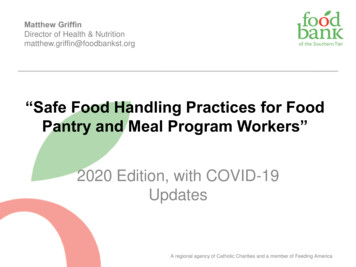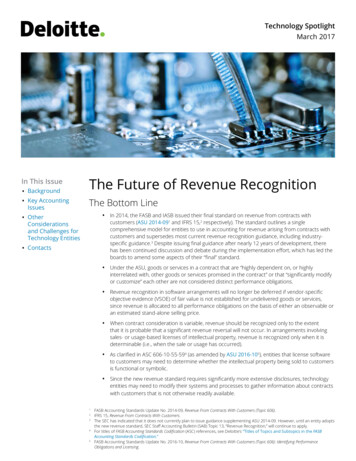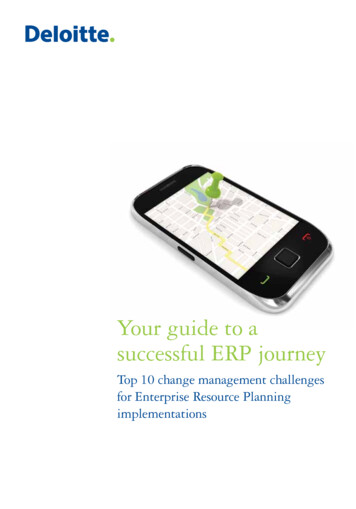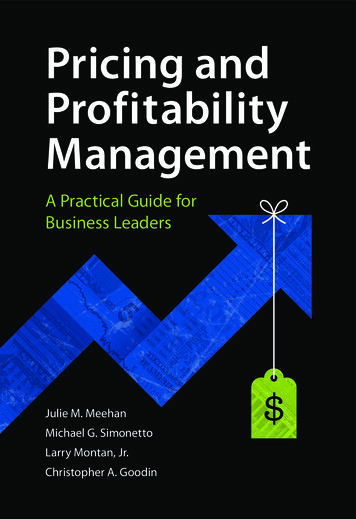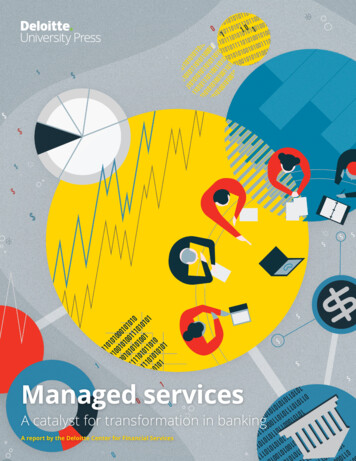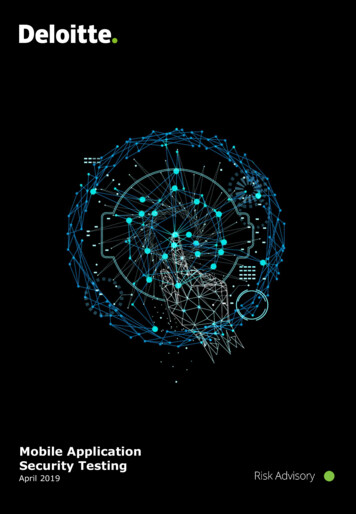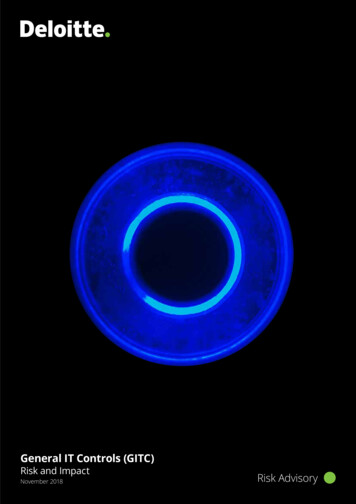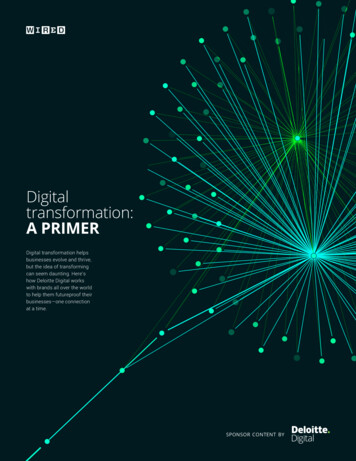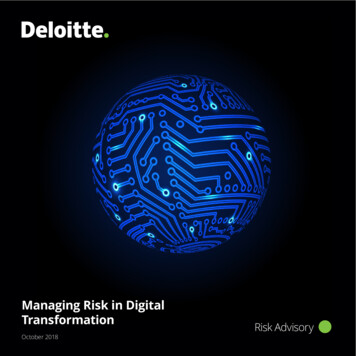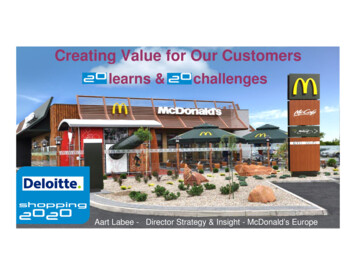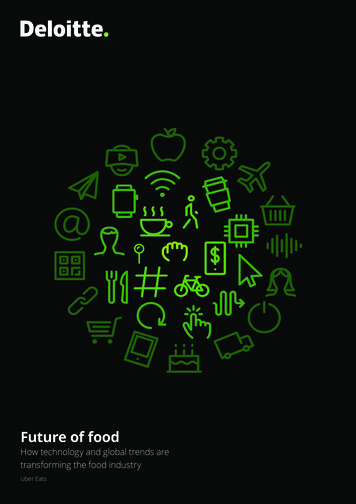
Transcription
Future of foodHow technology and global trends aretransforming the food industryUber Eats
Limitationof our workGeneral use restrictionThis report is prepared solely for the use ofUber. This report is not intended to and shouldnot be used or relied upon by anyone else andwe accept no duty of care to any other personor entity. The report has been prepared for thepurpose of exploring possible scenarios aroundthe future of food. You should not refer to or useour name or the advice for any other purpose.
Uber Eats Future of foodContentsThe state of play 1Changing tastes 4Scenario analysis 8One plate at a time 10Data driven food 12Master chef 14On trend 163
Future of food Uber EatsEvery day, 7.7 billion people around the world eat,consuming 14.5 million tonnes of food.1But what, when, where and how we eat varies significantlyby country and by consumer. Nowhere is that moreevident than in the Asia Pacific. The region is home tomore than half of the world’s population – 4.4 billionpeople, and dozens of cultures. Each country has its ownunique food traditions and preferences, from the spices ofIndia to the seasonal flavours of Japan. And each offers arange of ways of eating, from street food to fine dining.The region is home to a diverse and interrelated foodecosystem, from producers to retailers to consumers,which supports the rich food culture. Yet as technologyand consumer preferences shift, what and how we eat ischanging, sometimes in unexpected ways.The food ecosystem, and the relationship between itsplayers, is evolving to adapt to these changes. This canfeel challenging and uncertain for those in the industry.But with this change comes many new opportunitiesfor growth.In this report, Uber Eats has asked Deloitte to exploredifferent possible scenarios for the future of food, andwhat they mean for food businesses in the Asia Pacific.4
Uber Eats Future of foodThe state of playFood is a large – and growing – industry. Sometimes, foodis simple; straight from the farm to our plates. But moreoften, what we eat has been crafted by a range of people– grown by farmers, processed by manufacturers, sold togrocers, and finally cooked by restauranteurs.As a result of changing technology, consumerpreferences, globalisation and demographics, theindustry is evolving. The food ecosystem is becomingmore complex and more interdependent. This is drivenby consumers, whose spending on food, and fooddecisions, are shifting.Before we examine the future of the food industry inthe Asia Pacific, it’s important to look at the state ofplay today.Each individual player has an important role in the foodecosystem today, but it is through interactions thatthe industry creates sustenance, and experiences,for consumers.In the following pages, we look at the current state of thefood industry. Specifically, we focus on the big picturenumbers, spending on food and on prepared/ready toeat meals, and we drill down into food delivery.Figure 1: The food ecosystem in the pastThe food ecosystemGrocerHistorically, each player in the ‘food chain’ was distinctand operated independently. There was a reasonablyclear linear process to get food from paddock toplate (Figure t, like in many other industries, this landscape ischanging (Figure 2). New technologies are creating a more diversefood ecosystem. This ranges from new foodmanufacturers (for instance, the manufacturersof synthetic meats), to the rise of technologyenabled platforms which connect foodbusinesses to consumers, and online-onlyplayers offering convenient food at lower prices.Figure 2: The food ecosystem todayProducerProcessorWholesalerChanging consumer preferences are blurring thetraditional boundaries between players. Grocers arestarting to offer prepared meals, for example.RestaurantThis increasingly interconnected and interdependentfood ecosystem is creating more value and choicesfor consumers. The price of raw ingredients is fallingi(for example, the global cost of wheat has fallen 35%in real terms over the past 30 years),2 but the totalvalue of food is increasing; a result of more playersadding value through the supply chain.DelivererGrocerConsumeriThis is a result of technological advances, globalisation, and increasing competition.1
Future of food Uber EatsThe food budgetFood is a part of every household budget,yet the amount we spend can vary greatly.At the turn of the millennium, householdspending on food as a proportion ofdisposable income in the region rangedfrom 8% (Hong Kong) to over 40%(Sri Lanka).3But there are indicators that the shareof income spent on food across the AsiaPacific is beginning to converge. As shownin Figure 3, countries with relatively lowincomes are seeing food spending takeup a decreasing share of expenses asincomes increase. For example, in India,GDP per capita today is almost twicewhat is was 10 years ago, contributing tothe decline.4Convenience is kingSimultaneously, shifting preferences innations with higher incomes such as HongKong are seeing consumers increasinglywilling to spend on quality food. Asglobalisation and technological advancescreate new opportunities for innovationand more competition in the supply chain,our food spending is converging.iiThis is good news for restaurants. And it’snot all bad news in countries where spendas a share of income is falling, either:in many cases this is simply a reflection ofincomes rising faster than food budgets,with total spending on food increasing asa result.It is not just how much consumers spendthat has changed.Increasingly time-poor consumers havemore options than ever before, and weare witnessing a shift in the compositionof food spending. A greater share of foodbudgets is going towards food that isprepared outside the home. Around two infive Asian consumers say that dining out isone of their five fastest growing expenses.5This is old news in countries where a cultureof affordable eating out is well established.In particular, countries with strong streetfood industries, such as Malaysia andTaiwan, have long seen eating out make up asubstantial proportion of food expenditure.6Figure 3: Food spending as a percentage of disposable income in the Asia Pacific545Sri LankaIndia40China3530Thailand25TaiwanMalaysiaNew ZealandJapanSouth KoreaHong Kong201510Australia502000 2001 2002 2003 2004 2005 2006 2007 2008 2009 2010 2011 2012 2013 2014 2015 2016 2017 2018iiMeasured as a proportion of income.Food spending includes spending on food, beverages, and tobacco.iii62Source: The Economist Intelligence Unit (2019) and Deloitte Access Economics
Uber Eats Future of foodIn other countries, the rise in dining outis a more recent development, and is yetto reach its full potential. In Australia, forexample, money spent on meals preparedoutside the home has grown from 25%in the 1980s to more than one-third ofhousehold food expenditure today.7Convenience is not just about savingtime on cooking. It’s also about gettingthe food you want, when and where youwant it. Technology-enabled delivery – forgroceries, prepared meals, and ready to eatmeals – has increased dramatically over thelast decade. Rapid urbanisation and lowlabour costs across some markets in Asiaare especially well suited to home delivery.And consumers are taking full advantage.Close to half of Chinese consumers(46%) use online ordering and deliveryservices, almost double the globalaverage. And an even greater share saythey’ll use these services in the future.9Prepared mealsAs consumers become more time poor,prepared meals offer busy householdsa convenient way to source their meals.Usually only requiring reheating forconsumption, this delivery categoryis particularly popular among youngprofessionals.10 Industry revenue has alsogrown in the past five years – driven bya growing preference for personalisedmeals and increasing economies of scalefrom larger production volumes.11Ready to eat mealsThe delivery of restaurant meals to thehome has risen drastically in recentyears.12 One-third of consumers arenow using a restaurant or meal deliveryservice, and 7% of consumers get deliveryonce a week.13 This is driven by theexpansion of online-delivery platformsthat provide consumers with greaterchoice and convenience at dinner time.Restaurant-to-consumer delivery grew14% in Asia in the last year alone.14GroceriesAsia Pacific consumers rely less on brickand-mortar stores when purchasinggroceries than consumers in other partsof the world. 8Figure 4: Online food delivery revenue in the Asia Pacific (exc. China) in 2019, US h21SriLankaSource: Statista (2019) and Deloitte Access Economics37
Future of food Uber EatsChanging tastesWe know that the way people produce, procure andconsume food has changed significantly over the lastfew decades. However, eating habits will continueto evolve due to technological advances, changingconsumer preferences, and our growing population.Controlled systems are facilitating local foodproduction, while significantly increasing productivityand lowering costs. The vertical farm, for example,is shifting agriculture from rural locales to high-techurban indoor farms.These trends are complex, multi-layered, and interactwith each other in different ways.Next wave technologies such as the Internet ofThings and blockchain are transforming supplysystems, enabling both efficiency and transparency.It is now possible to track the location andtemperature of produce in real time, providingtransparency over the entire supply chain. Othertechnologies, such as virtual/augmented reality andnear real-time video streaming, are creating newexperiences for consumers.This section discusses how they are working togethertoday, and how this could impact the food ecosystem inthe future.Technology is disrupting thefood systemTechnology is rapidly being integrated into everypart of the food industry. But accelerating adoptionof existing technologies, as well a suite of newtechnologies emerging, creates both opportunitiesand challenges for food businesses.Data analytics and digital platforms offer businessesthe opportunity to understand customer preferencesin a way that was not previously possible. One areawhere technology can enable businesses to betterfulfil consumer preferences is through personalisedcatering en masse. This is especially important inthe context of increasingly complex consumerdietary requirements.Simultaneously, mobile apps and health trackers aremaking people more aware of the food they consume,and shaping preferences. Consumers are increasinglyasking businesses to put their ‘cards on the table’, andto provide open information about the nutrition andprovenance of food.On the supply side, businesses are looking at smartfood production. Food technology is starting torevolutionise the way we produce food, from 3Dprinting to synthetic meat.ivivFinally, the rise of the platform is creatingopportunities for food providers. Online foodordering and delivery platforms are providing newways for businesses to connect with consumers. It isincreasingly possible for even the smallest businessesto find new customers, allowing ‘a thousand flowers’to bloom. In food, this opens the door in particular forhome kitchens, where the ability to operate deliveryonly restaurants makes it possible to make a start,without the need for significant capital.Shifting preferences aretransforming consumptionEveryone must eat to live. However, for some of us,we increasingly live to eat. The way we choose what,when, how and why we eat is complex and changing.Our upbringing, where we live, what we believe in andour preferences, all affect our food choices.More and more, consumers are paying attention to theimpact of their food choices. Greater knowledge sharing,enabled by technology, is providing consumers withthe tools to seek out information about the food theyconsume. Across food, groceries, clothes and more,consumers are actively seeking ethically-conscious andsustainable products, and choosing brands that supportsocial issues that resonate with their beliefs.Shares in Silicon Valley start-up ‘Beyond Meat’ soared 163% on their first day of trading, and demand for plant based meat is growing.84
Uber Eats Future of foodThese issues vary from climate change awarenessto animal welfare, from ensuring living wages toavoiding unsafe labour practices. Interest in meat-freeconsumption is growing. This is sparking demandfor alternative sources of protein, such as tofu andsynthetic meats.33 The availability of guilty pleasures iscontributing to obesity. Yet on the other hand, someconsumers are increasingly searching for healthyfoods, and becoming more aware of the link betweendiet and health.Beyond what we eat, hectic schedules are changinghow, where and when time-poor consumers eat.Demand for convenience is growing, with over 50% ofconsumers eating out-of-home at least once a week.34It’s even affecting home cooking, with home deliveryof ready to eat meals and meal boxes becomingincreasingly common.Simultaneously, for some households, eating at homeis becoming more important. Preparing and eatingmeals at home is being seen as a way to safeguardfamily time, and to bring people together. The risein mindfulness about food, combined with thepopularity of blockbuster cooking shows, is creatingmore and more home-grown master chefs, who cookfor leisure. These consumers are driving demand forhigh quality and niche ingredients.Social media is increasingly driving our food choices.There are currently over 340 million posts onInstagram for #food.35 Food providers increasinglyhave to stay on trend by providing ‘Instagram-worthy’foods, like the ‘sushi-burrito’ or ‘cronut’. Visuallyappealing foods dominate social media feeds.The rise of the experience economy meanssuccessful restaurants must increasingly deliver adining experience that offers more than just taste.Consumers chase the latest food craze, religiouslykeeping up to date with what’s ‘hot’ in food. But, fadscan change with little warning. It’s great news forthose offering what’s hot, but the tides of fate canturn quickly, generating ‘winners and losers’.A changing population creatingchallenges and opportunities in foodThe face of consumers across the Asia Pacific todaywould have been unrecognisable 50 years ago. Theregion is also growing – by 2050, it’s expected thatthe Asia Pacific will be home to more than10 billion people.36It is estimated that Asia will be home to almost ninein 10 of the next billion middle-class consumers.37In 2015, Asia became richer than Europe for thefirst time in modern history.38 Rising incomes meanconsumers can afford to purchase better qualityfood, and more of it. Wealthier consumers are alsodemanding different types of food, with diets shiftingtowards more protein.39 Although, for a portion ofconsumers, putting food on the dinner table is theprimary concern.Increased access to information, coupled withincreasing literacy rates, is leading to a betterinformed population. Consumers are activelyresearching nutrition, and making more informedfood choices about what they eat.This region is also ageing at an unprecedentedrate. By 2050, one in four people in the Asia Pacificwill be over 60, each with their own set oftailored demands.40Coupled with rapid urbanisation, issues like foodsecurity are becoming paramount. While farminglabour is becoming more difficult to source, farmingtechnology is driving down the cost of production,and improving yields. However, food-calorieproduction will have to expand by 70% by 2050 tokeep pace with global population growth.41 Foodinsecurity is particularly relevant for Asia, which hasvery little suitable farming land remaining.42Climate change poses yet another challenge,as extreme weather events reduce farmingproductivity.43 Solving the challenge of feeding agrowing, ageing and more urbanised population in asustainable way, will increasingly become the focus forpolicy-makers.95
Future of food Uber EatsTechnological transformationPersonalised cateringConsumer preferences and requirements are changing andbecoming more complex. For instance, the number of people eatinggluten free or vegan is growing.15 Data analytics and digital platformswill allow food businesses to monitor these trends and create mealswhich are catered to every dietary need.Cards on the tableConsumers have greater access to data about food and nutrition,enabled by mobile apps and health trackers. Consumers are likely todemand this data be accurate, and businesses will feel pressure toprovide transparent information about food they provide. Moreover,providers will better understand customer preferences and valuedrivers as data becomes more available.16Food technologyAdvances in the production of food itself will change the way we eat.Businesses are looking at new ways to make food, from 3D printingto synthetic meat, and advances in storing fresh food. Shares inSilicon Valley start-up ‘Beyond Meat’ soared 163% on their first dayof trading.17Controlled systemsAs the climate becomes more extreme, crop production in openspaces may be threatened by weather events, poor soil quality orpests.18 Controlled systems allow producers to reliably grow crops,anywhere, in an environment such as a greenhouse or warehouse.These environments provide the opportunity to grow a wider varietyof crops at high quality, regardless of local conditions.Next waveNew technologies such as driverless cars and drones couldrevolutionise the food delivery industry. Similarly, AR and VR andvoice assistance tools could help customers engage with foodbusinesses, even when they are not dining in a restaurant.Rise of the platformPlatforms that connect people with services are growing at anunprecedented rate, and will continue to do so. Companies like eBay,Uber and Airbnb are disrupting conventional business models andallowing efficient transactions between consumers and businesses.In NSW (in Australia) alone, revenue earned in the collaborativeeconomy grew 68% in one year.19A thousand flowersThe internet allows small players to access new markets, openingup new opportunities for local food businesses. Today, 89% ofAustralian small businesses have a website, and some engagementwith social media.20Home kitchensThe accessibility of the internet is lowering the barriers to entry forhopeful food businesses. Delivery-only businesses can be run outof home kitchens or collaborative kitchens, reducing the need forsignificant upfront capital. And with smartphone penetration ratesgrowing (82% in developing countries),21 customers are increasinglyable to interact with food delivery businesses.6
Uber Eats Future of foodChanging consumer preferencesEthically-consciousFamily timeAlmost nine in 10 millennials would buy from companiesthat supported solutions to specific social issues.22Social awareness of issues such as sustainable supplychains, living wages, animal welfare and food waste areimpacting the brands consumers trust and what theychoose to consume.Mindful of their hectic schedules, many families aremaking meal times a priority. Three-quarters of parentswish they could spend more time with their family,26 andare using dinner time as a way to reconnect. For theseconsumers, preparing meals and eating together is anincreasingly important family tradition.Meat-free consumptionMaster chefOver 50% of Australians agree they’re ‘eating lessred meat these days’.23 The rise in the availability ofalternative protein sources, coupled with the associatedhealth, environmental and economic benefits fromeating less meat, is bolstering a plant-based ecosystem.While food preparation is a part of housework for many,it’s also considered an important leisure activity. Theability to outsource food preparation is changing theway people view cooking; moving from ‘foodwork’ to‘foodplay’. Consumers are looking to either outsourcepart of the food preparation process, or take the time tocook high quality meals at home.HealthyA growing awareness of the link between diet and healthhas seen consumers turn to clean eating to meet theirwellness goals. Specifically, 40% of young people aged18 to 30 are consuming a diet consistent with cleaneating.24 Consumers will increasingly demand foods thatare raw and unprocessed, avoiding foods high in sugar,fat or additives.ConvenienceAs a society, we are increasingly time poor, andconsumers increasingly value convenience whenpurchasing food.25 As food processes become morestreamlined, outsourcing will become more affordable.Mass adoption of technologies such as smartphonesfuel consumers’ expectations that their demands aremet in real-time. The value of their time will increasinglyoutweigh the costs of outsourcing food preparation,and consumers will increasingly order food online orchoose to eat out during meal times.Instagram-worthyThere are currently over 340 million posts on Instagramfor #food, and a further 124 million for #foodie.27Consumers are increasingly making choices about whatand where to eat based on the visual appeal of theirfood, and sharing images among a plethora of followers.For many, taste is secondary to ‘instagram-worthiness’.Experience economyGoods and services are increasingly accessible, andconsumers are moving away from buying things.Instead, they are looking to accumulate experiencesand memories. Successful restaurants are findingways to deliver a dining experience that offers morethan just taste.Winners and losersSocial media trends have the ability to shift customerpreferences in extreme ways, creating uneven, or bumpy,demand. There will be a handful of ‘superstar’ businessesthat take a substantive share of demand. But thesesuperstars will change with little warning, as consumersmove on to the next food craze.A growing and changing populationRising incomesAgeingIncomes are rising around the world, and consumerscan afford better quality food. Global GDP per capitahas increased 11-fold since 1870, and living standardshave improved considerably.28 Strong growth in theregion means that by 2030, 80% of the world’s middleclass (3.2 billion people) will live in Asia.29The population is ageing at unprecedented rate, andthe Asia Pacific is at the forefront of this phenomenonglobally. By 2050, one in four people in the region willbe over 60. The over 60 population will triple between2010 and 2050, reaching close to 1.3 billion people.31Better informedIncreased access to information and better schoolingis producing increasingly informed consumers. Theseconsumers are actively researching nutrition, andsearching for better food options. For instance, demandfor vegetables and fish increase with education, whiledemand for alcohol falls with education.30Rapid urbanisationThe Asia Pacific is also experiencing rapid urbanisation,and as of 2018 there are now more people living in urbanareas than rural.32 This mass exodus from the country hasimplications for both food demand and supply chains.117
Future of food Uber EatsScenario analysisPredicting the future of food and how differentWe then consider the potential impacts oftrends will impact producers, restaurants, andeach scenario:consumers if a challenging task. It is difficultto determine which trends will rise to the fore, This looks at what impact the scenario willhow they will interact with each other, andhave on total household food expenditure ashow they will be adopted in different countriesa proportion of income, relative to today.and cities.So rather than seeking to predict an uncertain This explores how the scenario affectsFood scenarios. Each is based on a differentconsumers’ decisions to make food at homecombination of trends discussed in theversus order food prepared by someoneprevious section.else – and therefore the impact of thescenario on revenue for restaurants, cafes,While each of these scenarios reflects acatering, and other food businesses relativedifferent possible future, the reality is thatto today.the future of food could be very different,scenarios, or reflecting a new fate entirely.The scenarios we explore are: One plate at a time – ethically and sociallyconscious consumers demand change. Data driven food – technologytakes the guesswork out of foodand eating. Master chef – quality food, whether cookedor delivered, brings people together. What proportion of consumers’ meals will bemade by someone else?future, we present four possible Future ofencompassing only elements of theseHow much will we spend? What proportion of consumers’ food will bedelivered?This looks at the possible impact of thescenario on delivery revenue – specifically,the proportion of food that consumers getdelivered relative to today. This impact is splitinto groceries (or ingredients), and prepared/ready-made meals.We use a combination of consultations,qualitative and quantitative research to informthe potential impact of each possible future.Where data exists, trends are extrapolated andOn trend – experience-hungry consumerscorrelations between key variables calculated,chase the latest craze.enabling us to estimate the impact of a changein one variable on broader food consumption.8
Uber Eats Future of food9
Future of food Uber EatsScenarioOne plateat a timeFood technologyControlled systemsA thousand flowersHome kitchensMeat-free consumptionHow much will we spend?The Asia Pacific already leads the world interms of ethical consumption.44 But, underthis scenario, we will see the number ofethical eaters increase significantly.However, eating ethically comes at aprice. Sustainable goods are in somecases up to 30% more expensive thanregular products.45A lot more than todayThe same as todayA lot less than todayEthically consciousRising incomesBetter informedAs the proportion of people willing to paythat premium increases, so too will totalfood spending.In this scenario, ethical consumptionbecomes the norm, and the food ecosystemis geared towards social and environmentalresponsibility. This scenario is about saving,and feeding the planet.There are two overlapping camps of ethicallyconscious eaters; environmentalists andwelfare-driven. Firstly, environmentalistsdemand food that has a minimal impact. Thisdemand is met by controlled systems andadvancing food technology. Food is labelledwith a carbon footprint rating and packagingis compostable.Meanwhile, better informed consumersare more concerned about welfare, eatinga predominantly meat-free diet, relying onsynthetic meats to reduce the need foranimal products.These two groups of consumers createdemand for food that is sourced and preparedlocally, supporting the rise of thousands ofsmaller restaurants and home kitchens.Larger brands that are able to build consumertrust will also flourish. While this produce ismore expensive, rising incomes mean thatconsumers are willing to pay thenecessary premium to minimise theirenvironmental footprint.How much of our food will beprepared by someone else?Ethical consumers seek to make informedfood choices. To do this, they requireinformation about where the food issourced, the ingredients used, and how itis prepared.The same as todayA lot less than todayConsumers looking for certainty willincreasingly choose to source and cooktheir own food, whether that be throughlocal farms or trusted suppliers. Existingevidence shows that ethical consumptionleads to a 13% declinev in restaurantspending per week.46When consumers do eat out, they will lookfor assurance that the meals are preparedin line with their beliefs. This sees largetrusted brands flourish, while smaller localrestaurants have the potential to draw innew crowds.v10A lot more than todayCalculated as a percentage decline based on average weekly expenditure on food.
Uber Eats Future of foodHow much of our food will bedelivered?GroceriesEnvironmental eaters look to minimisefood miles and waste in order to managetheir impact. However, convenience isstill important.What does it mean forindustry?A lot more than todayThe same as todayA lot less than normalTrusted brands with transparent supplychains will flourish in this scenario, asconsumers are willing to pay a premiumfor ethical produce – whether it beethically grown, ethically prepared,ethically sourced, or all of the above.Successful businesses will offerincreasingly customised products, whichenable customers to make food choicesthat reflect their ethical values. Forexample, environmentalists may opt toorder their lunch from platforms that usebike rather than car couriers, or that usepaper over plastic food packaging.As a result, consumers will look to havemore of their groceries delivered (forconvenience), but by local producersor co-ops.For restaurants, embodying a particularethos, and building a rapport withcustomers, will be key.How much of our food will bedelivered?Prepared/ready-made mealsA lot more than todayConsumers will do more cooking at home(to minimise their carbon footprint), whichmeans that delivery of ready-made foodwill fall. However, businesses that shift theirdelivery models to accommodate ethicalpreferences could increase their revenue.For instance, using bioplastics47 to reducefood packaging, or bike couriers48 ratherthan drivers, will attract new customers.The same as todayA lot less than today11
Future of food Uber EatsScenarioDatadriven foodFood technologyControlled systemsPersonalised cateringRise of the platformNext waveHealthyConvenienceRising incomesHow much will we spend?Technology-enabled efficienciesin agriculture see the costs of rawingredients decline. For the cost-consciousor no-frills eater, this means lower prices.However, few consumers will fit in thiscategory. Already, consumers are willingto pay up to twice as much on theirweekly food bill for a subscription mealkit service.viA lot more than todayThe same as todayA lot less than todayThe cost of food will be less determined bythe cost of
we increasingly live to eat. The way we choose what, when, how and why we eat is complex and changing. Our upbringing, where we live, what we believe in and our preferences, all affect our food choices.
